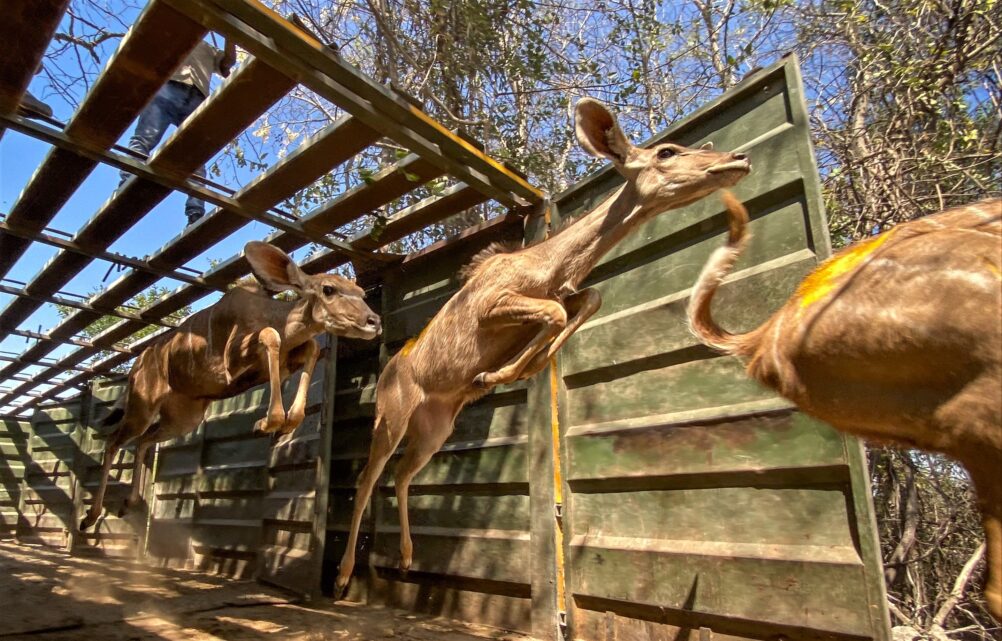Over the past three months, Peace Parks Foundation translocated 400 animals representing seven plains game species from a selection of reserves in Namibia to Simalaha Community Conservancy in Zambia.
This is yet another step in a long-term rewilding initiative aimed at supporting the Sesheke and Sekute Chiefdoms in restoring the conservancy’s ecosystems, and developing wildlife-based economies to the benefit of local communities.
This expansive translocation project was made possible thanks to generous funding from the MAVA Foundation, Dutch Postcode Lottery and other private donors.
Only native species are reintroduced, the majority of which existed historically in the area and now need their populations reinforced to flourish there once again. Released into the secure wildlife sanctuary, these species collectively fulfil vital ecosystem services. Grazing and browsing selectively process plant material and enrich soils in distinct ways, harmonizing the landscape with the wildlife existing in it. Each of these relocated species can disperse widely within the ecosystem and co-exist, for the large part, with livestock.
The latest groups of kudu, blue wildebeest, red lechwe, zebra and eland bring strength in numbers to ecosystems which, as they’re restored, can accommodate more animals – gradually, over 3 to 5 years, to allow for adaptation. Also brought in were giraffe and ostrich, representing newcomers to the area, but bringing with them important benefits lacking until now.
Flagship initiative
At a total area of 180 000 ha, Simalaha is a critical link within the Zambezi-Chobe Floodplain, a large wetland shared between Botswana, Namibia and Zambia. It joins the eastern Zambezi region in Namibia and the wetlands of the Chobe National Park in Botswana in forming the core ‘corridor’, connecting Chobe with Kafue National Park in Zambia. This entire and vital network of habitats is rooted within the Kavango Zambezi (KAZA) Transfrontier Conservation Area – the world’s largest cross-border protected area.

Central to this expanse, the conservancy has emerged as an exemplary model where the overall objective is to develop a sustainable wildlife economy based on strong community ownership, regenerative resource sharing, and local enterprise to support livelihoods.
Peace Parks has been supporting Simalaha since its inception in 2012, when the conservancy was founded upon the governance framework of the chiefdoms of the Sisheke and the Sekute, neighbours in the south and west of the province. A precedent-setting agreement was reached to contribute combined land to develop as a wildlife conservancy, with the conditions of local income generation through the development of a wildlife economy and, in the long-run, exciting tourism prospects.
In 2013, with the support of Peace Parks, the first wildlife translocation to Simalaha took place, building over time to 11 reintroduced species including sable, waterbuck, roan antelope, puku, lechwe and disease-free buffalo. The wildlife sanctuary has since expanded from an initial 22 000 ha to 55 000 ha to accommodate the growing species diversity and populations, with numbers increasing naturally to more than 3 674. The dedicated buffalo sanctuary’s population now surpasses 400, providing ample opportunity for generating profits from the sale of buffalo to other conservation areas.

Nature recovery, livelihood upliftment
The re-establishment of wildlife will gain momentum over time and, as it does, generate a new source of income to uplift communities out of poverty. In a more immediate timeframe, local livelihoods have been boosted by a range of restorative and profitable practices: sustainable agriculture, regenerative livestock herding and marketing carbon stocks, as well as specific programmes aimed at increasing biodiversity.
“The community attaches great value to the initiative through conservation and protection of wildlife and other natural resources; hence they participate in this venture with an eye on the future, whilst continuing with enhanced income-generating ventures such as conservation agriculture, bee keeping and Herding 4 Health, which will increase their potential to achieve conservation objectives,” said Luwodzya Mwale, Project Manager for the Kavango Zambezi Transfrontier Conservation Area.
The full value of southern Africa’s ecosystems and biodiversity, and utilising available natural resources sustainably, cannot be underestimated and the expansive benefits are impossible to replicate. This is a significant reason as to why rewilding and restoration programmes such as Simalaha’s, wherein community plays a powerful role, make an invaluable contribution to solving the combined climate and biodiversity crises.





